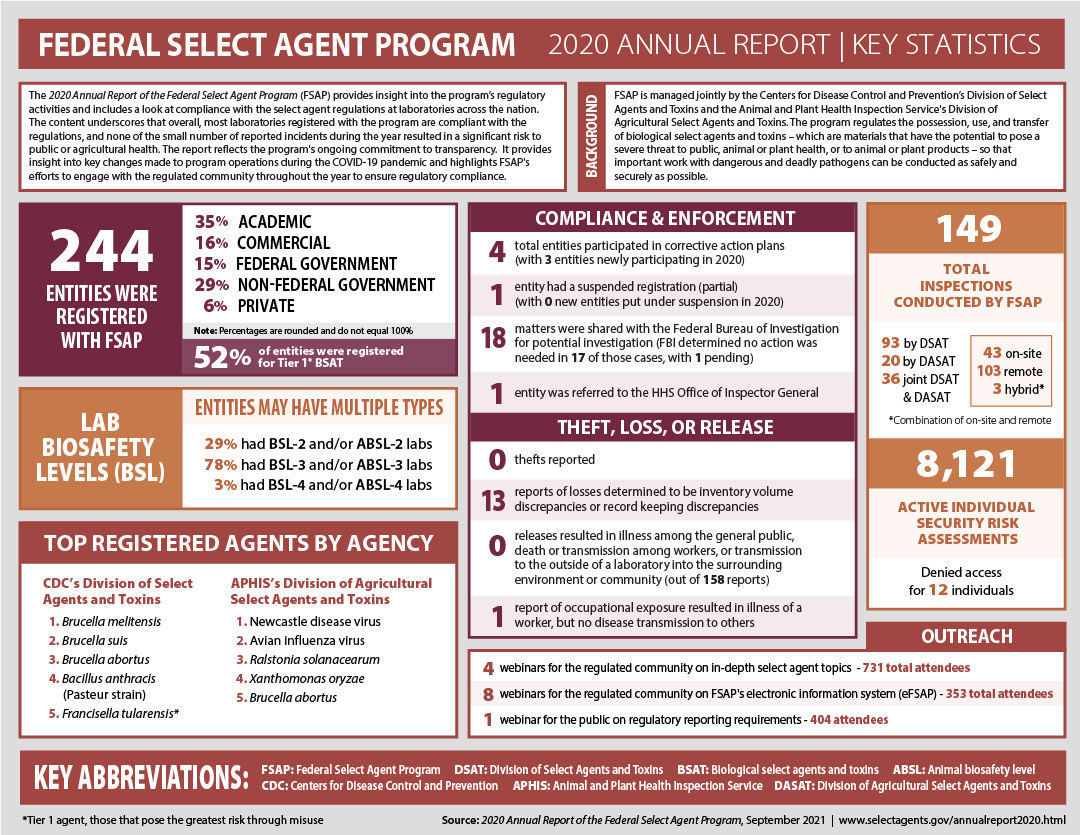2020 Annual Report of the Federal Select Agent Program:
Infographic of Findings
Download Infographic pdf icon[PDF – 119 KB]

FEDERAL SELECT AGENT PROGRAM
2020 Annual Report | Key Statistics
The 2020 Annual Report of the Federal Select Agent Program (FSAP) provides insight into the program’s regulatory activities and includes a look at compliance with the select agent regulations at laboratories across the nation. The content underscores that overall, most laboratories registered with the program are compliant with the regulations, and none of the small number of reported incidents during the year resulted in a significant risk to public or agricultural health. The report reflects the program’s ongoing commitment to transparency. It provides insight into key changes made to program operations during the COVID-19 pandemic and highlights FSAP’s efforts to engage with the regulated community throughout the year to ensure regulatory compliance.
BACKGROUND
FSAP is managed jointly by the Centers for Disease Control and Prevention’s Division of Select Agents and Toxins and the Animal and Plant Health Inspection Service’s Division of Agricultural Select Agents and Toxins. The program regulates the possession, use, and transfer of biological select agents and toxins – which are materials that have the potential to pose a severe threat to public, animal or plant health, or to animal or plant products – so that important work with dangerous and deadly pathogens can be conducted as safely and securely as possible.
244 ENTITIES WERE REGISTERED WITH FSAP
- 35% ACADEMIC
- 16% COMMERCIAL
- 15% FEDERAL GOVERNMENT
- 29% NON-FEDERAL GOVERNMENT
- 6% PRIVATE
Note: Percentages are rounded and do not equal 100%.
52% of entities are registered for Tier 1* BSAT
LAB BIOSAFETY LEVELS (BSL)
ENTITIES MAY HAVE MULTIPLE TYPES
- 29% have BSL-2 and/or ABSL-2 labs
- 78% have BSL-3 and/or ABSL-3 labs
- 3% have BSL-4 and/or ABSL-4 labs
TOP REGISTERED AGENTS BY AGENCY
CDC’s Division of Select Agents and Toxins
- Brucella melitensis
- Brucella suis
- Brucella abortus
- Bacillus anthracis
(Pasteur strain) - Francisella tularensis*
APHIS’s Division of Agricultural Select Agents and Toxins
- Newcastle disease virus
- Avian influenza virus
- Ralstonia solanacearum
- Xanthomonas oryzae
- Brucella abortus
COMPLIANCE & ENFORCEMENT
- 4 total entities participated in corrective action plans (with 3 entities newly participating in 2020)
- 1 entity had a suspended registration (partial) (with 0 new entities put under suspension in 2020)
- 18 matters were shared with the Federal Bureau of Investigation for potential investigation (FBI determined no action was needed in 17 of those cases, with 1 pending)
- 1 entity was referred to the HHS Office of Inspector General
THEFT, LOSS, OR RELEASE
- 0 thefts reported
- 13 reports of losses determined to be inventory volume discrepancies or record keeping discrepancies
- 0 releases resulted in illness among the general public, death or transmission among workers, or transmission to the outside of a laboratory into the surrounding environment or community (out of 158 reports)
- 1 report of occupational exposure resulted in illness of a worker, but no disease transmission to others
149 TOTAL INSPECTIONS CONDUCTED BY FSAP
- 93 by DSAT
- 20 by DASAT
- 36 joint DSAT & DASAT
- 43 on-site
- 103 remote
- 3 hybrid (combination of on-site and remote)
8,121 ACTIVE INDIVIDUAL SECURITY RISK ASSESSMENTS
- Denied access for 12 individuals
OUTREACH
- 4 webinars for the regulated community on in-depth select agent topics – 731 total attendees
- 8 webinars for the regulated community on FSAP’s electronic information system (eFSAP) – 353 total attendees
- 1 webinar for the public on regulatory reporting requirements – 404 attendees
KEY ABBREVIATIONS:
- FSAP: Federal Select Agent Program
- CDC: Centers for Disease Control and Prevention
- DSAT: Division of Select Agents and Toxins
- APHIS: Animal and Plant Health Inspection Service
- DASAT: Division of Agricultural Select Agents and Toxins
- BSAT: Biological select agents and toxins
- ABSL: Animal biosafety level
*Tier 1 agent, those that pose the greatest risk through misuse
Source: 2020 Annual Report of the Federal Select Agent Program, September 2021 | www.selectagents.gov/annualreport2020.htmlexternal icon